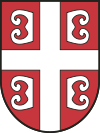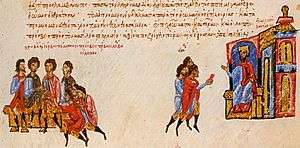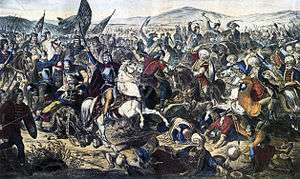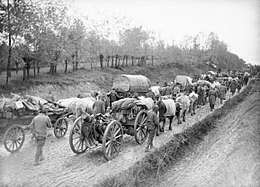History of the Serbs
| Part of a series of articles on |
| Serbs |
|---|
 |
|
Native communities |
|
Related groups |
Part of a series on the |
||||||||||||||||
|---|---|---|---|---|---|---|---|---|---|---|---|---|---|---|---|---|
| History of Serbia | ||||||||||||||||
 | ||||||||||||||||
|
||||||||||||||||
|
||||||||||||||||
|
||||||||||||||||
|
||||||||||||||||
|
||||||||||||||||
|
| ||||||||||||||||
The History of the Serbs spans from the Early Middle Ages to present. Serbs, a South Slavic people, traditionally live mainly in Serbia, Montenegro, Bosnia and Herzegovina, Croatia and Republic of Macedonia. A Serbian diaspora dispersed people of Serb descent to Western Europe and North America.
Middle Ages

Slavs settled in the Balkans in the 6th and 7th centuries, where they subsequently absorbed the local population (Illyrians, Thracians, Dacians, Romans, Celts).[1] The earliest found mention of the Serbs is from Einhard's Royal Frankish Annals, written in 822, when Ljudevit went from his seat at Sisak to the Serbs (believed to have been somewhere in western Bosnia),[2] with Einhard mentioning "the Serbs, who control the greater part of Dalmatia" (ad Sorabos, quae natio magnam Dalmatiae partem obtinere dicitur[3]).[2] The Serbs created numerous small states located in Bosnia and Herzegovina, Montenegro and Serbia. One of the most powerful Serbian states during this period was Raška, which separated from the Serbian state of Duklja in the 11th century.[1] Ruled by Grand Prince Stefan Nemanja from 1169 to 1196, Serbia conquered the neighbouring Slavic territories of Kosovo, Duklja and Zachumlje. Subsequently, he created the Nemanjić dynasty, which ruled over Serbia until the 14th century. Nemanja's older son, Stefan Nemanjić, became Serbia's first recognized king, while his younger son, Rastko, founded the Serbian Orthodox Church in the year 1219, and became known as Saint Sava after his death.[4]

Over the next 140 years, Serbia expanded its borders. Its cultural model remained Byzantine, despite political ambitions directed against the empire. The medieval power and influence of Serbia culminated in the reign of Stefan Dušan, who ruled the state from 1331 until his death in 1355. Ruling as Emperor from 1346, his territory included Macedonia, northern Greece, Montenegro, and almost all of Albania.[5] When Dušan died, his son Stephen Uroš V became Emperor.[6] With Turkish invaders beginning their conquest of the Balkans in the 1350s, a major conflict ensued between them and the Serbs, the first major battle was the Battle of Maritsa (1371),[7] in which the Serbs were defeated.[8] With the death of two important Serb leaders in the battle, and with the death of Stephen Uroš that same year, the Serbian Empire broke up into several small Serbian domains.[7] These states were ruled by feudal lords, with Zeta controlled by the Balšić family, Raška, Kosovo and northern Macedonia held by the Branković family and Lazar Hrebeljanović holding today's Central Serbia and a portion of Kosovo.[9] Hrebeljanović was subsequently accepted as the titular leader of the Serbs because he was married to a member of the Nemanjić dynasty.[7] In 1389, the Serbs faced the Ottomans at the Battle of Kosovo on the plain of Kosovo Polje, near the town of Pristina.[8] Both Lazar and Sultan Murad I were killed in the fighting.[10] The battle most likely ended in a stalemate, and Serbia did not fall to the Turks until 1459.[10] There exists c. 30 Serbian chronicles from the period between 1390 and 1526.[11]
Early modern period
The Serbs had taken an active part in the wars fought in the Balkans against the Ottoman Empire, and also organized uprisings.[12] Because of this, they suffered persecution and their territories were devastated.[12] Major migrations from Serbia into Habsburg territory ensued.[12] The period of Ottoman rule in Serbia lasted from the second half of 15th century to the beginning of the 19th century, interrupted by three periods of Habsburg occupation during later Habsburg-Ottoman wars.
In early 1594, the Serbs in Banat rose up against the Ottomans.[13] The rebels had, in the character of a holy war, carried war flags with the icon of Saint Sava.[14] After suppressing the uprising, the Ottomans publicly incinerated the relics of Saint Sava at the Vračar plateau on April 27, 1595.[14] The incineration of Sava's relics provoked the Serbs, and empowered the Serb liberation movement. From 1596, the center of anti-Ottoman activity in Herzegovina was the Tvrdoš Monastery in Trebinje.[15] An uprising broke out in 1596, but the rebels were defeated at the field of Gacko in 1597, and were forced to capitulate due to the lack of foreign support.[15]
After allied Christian forces had captured Buda from the Ottoman Empire in 1686 during the Great Turkish War, Serbs from Pannonian Plain (present-day Hungary, Slavonia region in present-day Croatia, Bačka and Banat regions in present-day Serbia) joined the troops of the Habsburg Monarchy as separate units known as Serbian Militia.[16] Serbs, as volunteers, massively joined the Austrian side.[17] In 1688, the Habsburg army took Belgrade and entered the territory of present-day Central Serbia. Louis William, Margrave of Baden-Baden called Serbian Patriarch Arsenije III Čarnojević to raise arms against the Turks; the Patriarch accepted and returned to the liberated Peć. As Serbia fell under Habsburg control, Leopold I granted Arsenije nobility and the title of duke. In early November, Arsenije III met with Habsburg commander-in-chief, General Enea Silvio Piccolomini in Prizren; after this talk he sent a note to all Serb bishops to come to him and collaborate only with Habsburg forces.
A large migration of Serbs to Habsburg lands was undertaken by Patriarch Arsenije III.[18] The large community of Serbs concentrated in Banat, southern Hungary and the Military Frontier included merchants and craftsmen in the cities, but mainly refugees that were peasants.[18] Serbia remained under Ottoman control until the early 19th century, with the eruption of the Serbian Revolution in 1804.
Modern period
19th century
The uprising ended in the early 1830s, with Serbia's autonomy and borders being recognized, and with Miloš Obrenović being recognized as its ruler. The last Ottoman troops withdrew from Serbia in 1867, although Serbia's independence was not recognized internationally until the Congress of Berlin in 1878.[19] When the Principality of Serbia gained independence from the Ottoman Empire, Orthodoxy became crucial in defining the national identity, instead of language which was shared by other South Slavs (Croats and Muslims).[20]
20th century

Serbia fought in the Balkan Wars of 1912–13, which forced the Ottomans out of the Balkans and doubled the territory and population of the Kingdom of Serbia. In 1914, a young Bosnian Serb student named Gavrilo Princip assassinated Archduke Franz Ferdinand of Austria, which directly contributed to the outbreak of World War I.[21] In the fighting that ensued, Serbia was invaded by Austria-Hungary. Despite being outnumbered, the Serbs subsequently defeated the Austro-Hungarians at the Battle of Cer, which marked the first Allied victory over the Central Powers in the war.[22] Further victories at the battles of Kolubara and the Drina meant that Serbia remained unconquered as the war entered its second year. However, an invasion by the forces of Germany, Austria-Hungary and Bulgaria overwhelmed the Serbs in the winter of 1915, and a subsequent withdrawal by the Serbian Army through Albania took the lives of more than 240,000 Serbs. Serb forces spent the remaining years of the war fighting on the Salonika Front in Greece, before liberating Serbia from Austro-Hungarian occupation in November 1918.[23]
Serbs subsequently formed the Kingdom of Serbs, Croats and Slovenes with other South Slavic peoples. The country was later renamed the Kingdom of Yugoslavia, and was led from 1921 to 1934 by King Alexander I of the Serbian Karađorđević dynasty.[24] In the period of 1920–31, Serb and other South Slavic families of the Kingdom of Hungary (and Serbian-Hungarian Baranya-Baja Republic) were given the option to leave Hungary for the Kingdom of Yugoslavia, and thereby change citizenship (these were called optanti).

During World War II, Yugoslavia was invaded by the Axis powers in April 1941. The country was subsequently divided into many pieces, with Serbia being directly occupied by the Germans.[25] Serbs in the Independent State of Croatia (NDH) experienced persecution at the hands of the Croatian ultra-nationalist, fascist Ustaše, who attempted to exterminate the Serb population in death camps. More than half a million Serbs were killed in the territory of Yugoslavia during World War II.[26] Serbs in occupied Yugoslavia subsequently formed a resistance movement known as the Yugoslav Army in the Homeland, or the Chetniks. The Chetniks had the official support of the Allies until 1943, when Allied support shifted to the Communist Yugoslav Partisans, a multi-ethnic force, formed in 1941, which also had a large majority of Serbs in its ranks in the first two years of war, later, after the fall of Italy, September 1943. other ethnic groups joined Partisans in larger numbers.[25] At the end of the war, the Partisans, led by the Croat Josip Broz Tito, emerged victorious. Yugoslavia subsequently became a Communist state. Tito died in 1980, and his death saw Yugoslavia plunge into economic turmoil.[27]
Yugoslavia disintegrated in the early 1990s, and a series of wars resulted in the creation of five new states. The heaviest fighting occurred in Croatia and Bosnia and Herzegovina, whose Serb populations rebelled and sought unification with Serbia, which was then still part of the Federal Republic of Yugoslavia. The war in Croatia ended in August 1995, with a Croatian military offensive known as Operation Storm crushing the Croatian Serb rebellion and causing as many as 200,000 Serbs to flee the country. The Bosnian War ended that same year, with the Dayton Agreement dividing the country along ethnic lines. In 1998–99, a conflict in Kosovo between the Yugoslav Army and Albanians seeking independence erupted into full-out war, resulting in a 78-day-long NATO bombing campaign which effectively drove Yugoslav security forces from Kosovo.[28] Subsequently, more than 200,000 Serbs and other non-Albanians fled the province.[29] On 5 October 2000, Yugoslav President Slobodan Milosević was overthrown in a bloodless revolt after he refused to admit defeat in the 2000 Yugoslav general election.[30]
Cultural history
Serbian Revival
The Serbian Revival refers to a period in the history of the Serbs between the 18th century and the de jure establishment of the Principality of Serbia (1878). It began in Habsburg territory, in Sremski Karlovci.[31] The "Serbian renaissance" is said to have begun in 17th-century Banat.[32] The Serbian Revival began earlier than the Bulgarian National Revival.[33] The first revolt in the Ottoman Empire to acquire a national character was the Serbian Revolution (1804–1817),[31] which was the culmination of the Serbian renaissance.[34] According to Jelena Milojković-Djurić: "The first literary and learned society among the Slavs was Matica srpska, founded by the leaders of Serbian revival in Pest in 1826."[35] Vojvodina became the cradle of the Serbian renaissance during the 19th century.[36] Vuk Stefanović Karadžić (1787–1864) was the most instrumental in this period.[37][38]
Maps
 Ethnic territory of the Serbs and South Slavs in the Pannonian Plain between 16th and 18th century (according to Jovan Cvijić and Dr Dušan J. Popović)
Ethnic territory of the Serbs and South Slavs in the Pannonian Plain between 16th and 18th century (according to Jovan Cvijić and Dr Dušan J. Popović) Serbs in Serbia as per 2002 census data for Central Serbia and Vojvodina, and 1991 census data for Kosovo
Serbs in Serbia as per 2002 census data for Central Serbia and Vojvodina, and 1991 census data for Kosovo Serbs in Montenegro as per 2003 census data
Serbs in Montenegro as per 2003 census data Serbs (blue) in Bosnia and Herzegovina as per 2013 census
Serbs (blue) in Bosnia and Herzegovina as per 2013 census
See also
References
- 1 2 Miller 2005, p. 533.
- 1 2 Ćirković, Sima (2004). The Serbs. Malden: Blackwell Publishing. pp. 14–15.
- ↑ Einhard (1845). Einhardi Annales. Hahn. pp. 83–.
ad Sorabos, quae natio magnam Dalmatiae partem obtinere dicitur
- ↑ Cox 2002, p. 20.
- ↑ Cox 2002, p. 21.
- ↑ Cox 2002, p. 23.
- 1 2 3 Cox 2002, pp. 23–24.
- 1 2 Judah 2002, p. 5.
- ↑ Judah 2000, p. 27.
- 1 2 Judah 2002, p. 7–8.
- ↑ Dvornik 1962, p. 174.
- 1 2 3 Ga ́bor A ́goston; Bruce Alan Masters (1 January 2009). Encyclopedia of the Ottoman Empire. Infobase Publishing. pp. 518–. ISBN 978-1-4381-1025-7.
- ↑ Rajko L. Veselinović (1966). (1219-1766). Udžbenik za IV razred srpskih pravoslavnih bogoslovija. (Yu 68-1914). Sv. Arh. Sinod Srpske pravoslavne crkve. pp. 70–71.
- 1 2 Nikolaj Velimirović (January 1989). The Life of St. Sava. St. Vladimir's Seminary Press. p. 159. ISBN 978-0-88141-065-5.
- 1 2 Ćorović 2001, Преокрет у држању Срба
- ↑ Gavrilović, Slavko (2006), "Isaija Đaković", Zbornik Matice Srpske za Istoriju (PDF) (in Serbian), 74, Novi Sad: Matica Srpska, Department of Social Sciences, Proceedings i History, p. 7, archived from the original (pdf) on 16 September 2011, retrieved 21 December 2011
- ↑ Janićijević, Jovan (1996), Kulturna riznica Srbije (in Serbian), IDEA, p. 70,
Велики или Бечки рат Аустрије против Турске, у којем су Срби, као добровољци, масовно учествовали на аустријској страни
- 1 2 Jelavich 1983, p. 145.
- ↑ Ágoston & Masters 2009, pp. 518–519.
- ↑ Christopher Catherwood (1 January 2002). Why the Nations Rage: Killing in the Name of God. Rowman & Littlefield. pp. 135–. ISBN 978-0-7425-0090-7.
- ↑ Miller 2005, p. 542.
- ↑ Pavlowitch 2002, p. 94.
- ↑ Miller 2005, pp. 542–543.
- ↑ Miller 2005, p. 544.
- 1 2 Miller 2005, p. 545.
- ↑ Yugoslavian Front (WWII)#Casualties
- ↑ Miller 2005, pp. 546–553.
- ↑ Miller 2005, pp. 558–562.
- ↑ Gall 2000.
- ↑ Pavlowitch 2002, p. 225.
- 1 2 M. Şükrü Hanioğlu (8 March 2010). A Brief History of the Late Ottoman Empire. Princeton University Press. pp. 51–. ISBN 1-4008-2968-2.
- ↑ Francis Deák (1942). Hungary at the Paris Peace Conference: The Diplomatic History of the Treaty of Trianon. Columbia University Press. p. 370.
- ↑ Viktor Novak (1980). Revue historique.
Иако је српски препород старији од бугар- ског, они су се надопуњивали. Књижевно „славеносрпски" и „сла- веноблгарски" су били блиски један другом, „нису се много разли- ковали и једнако су били доступни и за наше и за ...
- ↑ Fred Singleton (21 March 1985). A Short History of the Yugoslav Peoples. Cambridge University Press. pp. 72–. ISBN 978-0-521-27485-2.
- ↑ Jelena Milojković-Djurić (1994). Panslavism and national identity in Russia and in the Balkans, 1830-1880: images of the self and others. East European Monographs. p. 21.
- ↑ Paul Robert Magocsi (2002). Historical Atlas of Central Europe. University of Toronto Press. pp. 34–. ISBN 978-0-8020-8486-6.
- ↑ Ingrid Merchiers (2007). Cultural Nationalism in the South Slav Habsburg Lands in the Early Nineteenth Century: The Scholary Network of Jernej Kopitar (1780-1844). DCL Print & Sign. ISBN 978-3-87690-985-1.
The Serbian revival is especially linked with the name of Vuk Stefanovic Karadzic, who has been extensively studied and the subject of numerous monographs.
- ↑ Soviet Literature. Foreign Languages Publishing House. January 1956.
He helped Vuk Karadzich, prominent in the Serbian Renaissance, and one of the leading figures in the educational movement of his times,
Sources
- Primary sources
- Moravcsik, Gyula, ed. (1967) [1949]. Constantine Porphyrogenitus: De Administrando Imperio (2nd revised ed.). Washington D.C.: Dumbarton Oaks Center for Byzantine Studies.
- Constantine VII Porphyrogenitus (1840). De Ceremoniis (Reiske, J. J. ed.). Impensis E. Weberi.
- Pertz, Georg Heinrich, ed. (1845). Einhardi Annales. Hanover.
- Scholz, Bernhard Walter, ed. (1970). Carolingian Chronicles: Royal Frankish Annals and Nithard's Histories. University of Michigan Press.
- Thurn, Hans, ed. (1973). Ioannis Scylitzae Synopsis historiarum. Berlin-New York: De Gruyter.
- Шишић, Фердо, ed. (1928). Летопис Попа Дукљанина (Chronicle of the Priest of Duklja). Београд-Загреб: Српска краљевска академија.
- Кунчер, Драгана (2009). Gesta Regum Sclavorum. 1. Београд-Никшић: Историјски институт, Манастир Острог.
- Живковић, Тибор (2009). Gesta Regum Sclavorum. 2. Београд-Никшић: Историјски институт, Манастир Острог.
- Secondary sources
- Babac, Dušan M. (2016). The Serbian Army in the Great War, 1914-1918. Solihull: Helion.
- Bataković, Dušan T. (1996). The Serbs of Bosnia & Herzegovina: History and Politics. Paris: Dialogue.
- Bataković, Dušan T., ed. (2005). Histoire du peuple serbe [History of the Serbian People] (in French). Lausanne: L’Age d’Homme.
- Bulić, Dejan (2013). "The Fortifications of the Late Antiquity and the Early Byzantine Period on the Later Territory of the South-Slavic Principalities, and their re-occupation". The World of the Slavs: Studies of the East, West and South Slavs: Civitas, Oppidas, Villas and Archeological Evidence (7th to 11th Centuries AD). Istorijski institut SANU. pp. 137–234.
- Ćirković, Sima (2004). The Serbs. Malden: Blackwell Publishing.
- Cox, John K. (2002). The History of Serbia. Westport, Connecticut: Greenwood Press.
- Curta, Florin (2001). The Making of the Slavs: History and Archaeology of the Lower Danube Region, c. 500–700. Cambridge: Cambridge University Press.
- Curta, Florin (2006). Southeastern Europe in the Middle Ages, 500–1250. Cambridge: Cambridge University Press.
- DiNardo, Richard L. (2015). Invasion: The Conquest of Serbia, 1915. Santa Barbara: Praeger.
- Dragnich, Alex N., ed. (1994). Serbia's Historical Heritage. New York: Columbia University Press.
- Dragnich, Alex N. (2004). Serbia Through the Ages. Boulder: East European Monographs.
- Dvornik, Francis (1962). The Slavs in European History and Civilization. New Brunswick: Rutgers University Press.
- Fine, John Van Antwerp Jr. (1991) [1983]. The Early Medieval Balkans: A Critical Survey from the Sixth to the Late Twelfth Century. Ann Arbor, Michigan: University of Michigan Press.
- Fine, John Van Antwerp Jr. (1994) [1987]. The Late Medieval Balkans: A Critical Survey from the Late Twelfth Century to the Ottoman Conquest. Ann Arbor, Michigan: University of Michigan Press.
- Fryer, Charles (1997). The Destruction of Serbia in 1915. New York: Columbia University Press.
- Gavrilović, Zaga (2001). Studies in Byzantine and Serbian Medieval Art. London: The Pindar Press.
- Gumz, Jonathan E. (2009). The Resurrection and Collapse of Empire in Habsburg Serbia, 1914-1918. Cambridge: Cambridge University Press.
- Hehn, Paul N. (1971). "Serbia, Croatia and Germany 1941-1945: Civil War and Revolution in the Balkans". Canadian Slavonic Papers. 13 (4): 344–373. JSTOR 40866373.
- Ingrao, Charles; Samardžić, Nikola; Pešalj, Jovan, eds. (2011). The Peace of Passarowitz, 1718. West Lafayette: Purdue University Press.
- Ivić, Pavle, ed. (1995). The History of Serbian Culture. Edgware: Porthill Publishers.
- Jelavich, Barbara (1983a). History of the Balkans: Eighteenth and Nineteenth Centuries. 1. Cambridge University Press.
- Jelavich, Barbara (1983b). History of the Balkans: Twentieth Century. 2. Cambridge University Press.
- Jireček, Constantin (1911). Geschichte der Serben. 1. Gotha: Perthes.
- Jireček, Constantin (1918). Geschichte der Serben. 2. Gotha: Perthes.
- Luttwak, Edward N. (2009). The Grand Strategy of the Byzantine Empire. Harvard University Press.
- Lyon, James B. (2015). Serbia and the Balkan Front, 1914: The Outbreak of the Great War. London: Bloomsbury.
- McCormick, Rob (2008). "The United States' Response to Genocide in the Independent State of Croatia, 1941–1945". Genocide Studies and Prevention. 3 (1): 75–98.
- Miller, Nicholas (2005). "Serbia and Montenegro". Eastern Europe: An Introduction to the People, Lands, and Culture. 3. Santa Barbara, California: ABC-CLIO. pp. 529–581.
- Mitrović, Andrej (2007). Serbia's Great War 1914-1918. West Lafayette: Purdue University Press.
- Obolensky, Dimitri (1974) [1971]. The Byzantine Commonwealth: Eastern Europe, 500-1453. London: Cardinal.
- Orbini, Mauro (1601). Il Regno de gli Slavi hoggi corrottamente detti Schiavoni. Pesaro: Apresso Girolamo Concordia.
- Орбин, Мавро (1968). Краљевство Словена. Београд: Српска књижевна задруга.
- Ostrogorsky, George (1956). History of the Byzantine State. Oxford: Basil Blackwell.
- Pavlovich, Paul (1989). The History of the Serbian Orthodox Church. Serbian Heritage Books.
- Pavlowitch, Stevan K. (2002). Serbia: The History behind the Name. London: Hurst & Company.
- Pavlowitch, Stevan K. (2008). Hitler's new disorder: The Second World War in Yugoslavia. New York: Columbia University Press.
- Pisarri, Milovan (2013). "Bulgarian Crimes Against Civilians in Occupied Serbia during the First World War". Balcanica. 44: 357–390.
- Popović, Svetlana (2002). "The Serbian Episcopal sees in the thirteenth century (Српска епископска седишта у XIII веку)". Старинар (51): 2001. More than one of
|pages=and|page=specified (help) - Radić, Radmila (2007). "Serbian Christianity". The Blackwell Companion to Eastern Christianity. Malden, MA: Blackwell Publishing. pp. 231–248.
- Samardžić, Radovan; Duškov, Milan, eds. (1993). Serbs in European Civilization. Belgrade: Nova, Serbian Academy of Sciences and Arts, Institute for Balkan Studies.
- Stanković, Vlada, ed. (2016). The Balkans and the Byzantine World before and after the Captures of Constantinople, 1204 and 1453. Lanham, Maryland: Lexington Books.
- Temperley, Harold W. V. (1919) [1917]. History of Serbia (PDF) (2 ed.). London: Bell and Sons.
- Tomasevich, Jozo (2001). War and Revolution in Yugoslavia, 1941-1945: Occupation and Collaboration. Stanford: Stanford University Press.
- Živković, Tibor; Bojanin, Stanoje; Petrović, Vladeta, eds. (2000). Selected Charters of Serbian Rulers (XII-XV Century): Relating to the Territory of Kosovo and Metohia. Athens: Center for Studies of Byzantine Civilisation.
- Живковић, Тибор (2000). Словени и Ромеји: Славизација на простору Србије од VII до XI века (The Slavs and the Romans). Београд: Историјски институт САНУ, Службени гласник.
- Живковић, Тибор (2002). Јужни Словени под византијском влашћу 600-1025 (South Slavs under the Byzantine Rule 600-1025). Београд: Историјски институт САНУ, Службени гласник.
- Живковић, Тибор (2004). Црквена организација у српским земљама: Рани средњи век (Organization of the Church in Serbian Lands: Early Middle Ages). Београд: Историјски институт САНУ, Службени гласник.
- Живковић, Тибор (2006). Портрети српских владара: IX-XII век (Portraits of Serbian Rulers: IX-XII Century). Београд: Завод за уџбенике и наставна средства.
- Živković, Tibor (2007). "The Golden Seal of Stroimir" (PDF). Historical Review. Belgrade: The Institute for History. 55: 23–29.
- Živković, Tibor (2008). Forging unity: The South Slavs between East and West 550-1150. Belgrade: The Institute of History, Čigoja štampa.
- Živković, Tibor (2011). "The Origin of the Royal Frankish Annalist's Information about the Serbs in Dalmatia". Homage to Academician Sima Ćirković. Belgrade: The Institute for History. pp. 381–398.
- Živković, Tibor (2012). De conversione Croatorum et Serborum: A Lost Source. Belgrade: The Institute of History, Čigoja štampa.
- Živković, Tibor (2013a). "On the Baptism of the Serbs and Croats in the Time of Basil I (867–886)" (PDF). Studia Slavica et Balcanica Petropolitana (1): 33–53.
- Živković, Tibor (2013b). "The Urban Landcape of Early Medieval Slavic Principalities in the Territories of the Former Praefectura Illyricum and in the Province of Dalmatia (ca. 610-950)". The World of the Slavs: Studies of the East, West and South Slavs: Civitas, Oppidas, Villas and Archeological Evidence (7th to 11th Centuries AD). Belgrade: The Institute for History. pp. 15–36.
